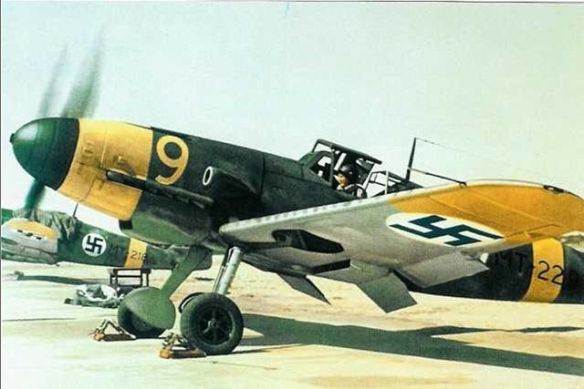Finnish Air Force: Messerschmitt Bf 109 G-2 fighter at Helsinki Malmi airport in June 1943.
The Finnish Air Force (FAF or FiAF) is one of the branches of the Finnish Defence Forces. Its peacetime tasks are airspace surveillance, identification flights, and production of readiness formations for wartime conditions. As a separate branch of the military, the Finnish Air Force was founded on 4 May 1928, having existed officially since 6 March 1918 as the Army Corps of Aviation.
In the 1930s, two controversies hindered Finnish aircraft acquisition. The first was the issue of whether fighters or bombers should have priority (the need for fighters seeming paramount). The second was the country from which to purchase aircraft. The head of the Defense Council, Carl Mannerheim, favored Germany, and the air force commander, Colonel Jarl Lundquist (later a lieutenant general), favored Britain. Mannerheim stressed the danger of air attacks on Finnish cities when arguing for more funds for the air force, but he gave priority to air support for ground forces when war came. In September 1939, the Finnish Air Force (FAF) had only 36 modern interceptors (Dutch Fokker D-XXIs) and 21 bombers (14 Bristol Blenheims and 7 Junkers K430s). Lundquist deployed his limited fighter assets forward to protect the army and defend as much Finnish air space as possible. Following the Soviet invasion of Finland in November 1939, Finnish bombers attacked airfields and supported ground forces. In late December 1939, the FAF was able to purchase additional Fokker fighters, but its best aircraft came in the form of Morane-Saulnier MS-406s purchased from France. The Finns purchased additional Blenheims, U. S. Brewster F2A Buffalos (the Finns enjoyed considerable success with this much-maligned aircraft), Italian Fiat G-50s, and additional MS 406s. Most arrived too late for the war.
During this Finnish-Soviet War of 1939-1940, also called the Winter War, the FAF supposedly accounted for approximately 200 Soviet aircraft, and more than 300 others were destroyed by antiaircraft fire or on the ground. Finnish losses during the war amounted to 62 aircraft.
In 1941, when Finland again went to war with the Soviet Union (the Finnish-Soviet War of 1941-1944, also called the Continuation War), Finland’s air force had increased substantially. It possessed 144 modern fighters (a mixture of U. S., British, French, Dutch, and Italian planes); 44 British and ex-Soviet bombers; and 63 mostly British and German reconnaissance planes. Once the Continuation War began, Finnish access to aircraft from other nations except Germany was cut off. The Finns did have their own aircraft industry, which produced limited numbers of aircraft including the VL Myrsky II fighter.
Finnish Air Force strategy stressed aggressiveness; isolated fighters usually attacked no matter the number of Soviet aircraft. The FAF employed a blue swastika marking (no relation to the Nazi version) for national identification. The Luftwaffe and FAF cooperated in this conflict, although neither could prevent Soviet air raids into Finnish territory nor completely screen the Finnish army from air attacks.
Finnish Air Force (in Russo-Finnish Wars)
Seeds of tradition were sown in the Ilmailuvoimat (the Finnish Air Force) during the Winter War (30 November 1939-12 March 1940) against the Soviet Union. Finnish air operations hit their stride during the Continuation War, so called because it continued the conflict begun by the Soviets in 1939. The first real combat for the Ilmailuvoimat occurred during the Soviet invasion of Finland. In this war, the Finns scored 190 confirmed kills and more than 100 probables. They achieved a 16:1 ratio with the Soviets-in aerial combat, the Finns shot down 16 Soviets for every one of theirs the Soviets downed.
The small and ill-equipped Ilmailuvoimat followed certain principals to ensure success. First, by concentrating its fighter power and using the element of surprise, it achieved temporary air superiority. Second, it flew in small, flexible formations. Next, it demanded that its pilots be skilled in aerobatics and combat maneuvers. Finally, Finnish pilots were continuously trained until they were masters in shooting accuracy.
Although Finland did not share the Nazi political ideology, it still formed an alliance with Germany to defend itself against the Soviet Union. When Hitler invaded the Soviet Union on 22 June 1941, Finland went to war. The air force began the Continuation War with 120 fighters (Brewsters, Fiats, Curtisses, Morane-Saulniers, and Hurricanes) and 58 mostly obsolete reconnaissance planes.
Initially, the Finns were quite successful against the Soviets, achieving a 32:1 exchange ratio. As the war went on, the Finnish forces became less effective despite the acquisition of limited numbers of German Messerschmitt Bf 109Gs and Junkers Ju 88s.
The Battle of the Gulf of Finland is the best example of air operations during the war. The Finnish fighter pilots were successful, attaining an average exchange ratio of 25:1. Their strategy of focusing on aerial combat made the difference; raids on Soviet air bases were not worth the risk. The Soviets had no shortage of aircraft but lacked experienced pilots. By focusing on eliminating these trained Soviet pilots, the Finns achieved air superiority.
The Soviets did not wish to spend what was necessary to defeat the Finns militarily, so on 4 September 1944 a peace agreement was signed. The Ilmailuvoimat again finished a war with more fighters than it started with. Finland ended with the largest proportion of aces in the world in relation to population. Most of the Finn aces survived the war.
References Kirby, D. G. Finland in the Twentieth Century. Minneapolis: University of Minnesota Press, 1979. Tillotson, H. M. Finland at Peace and War, 1918-1993. Wilby, UK: Michael Russell, 1993. Trotter, William R. A Frozen Hell: The Russo-Finnish War of 1939-40. Chapel Hill, NC: Algonquin Books, 1991. Nikunen, Lieutenant General (ret.) Heikki. The Finnish Air Force (FAF): A Historical Review. Helsinki: Finnish Air Force, 1993.
